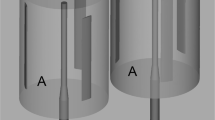Abstract
A stabilized finite element algorithm potential for wind-structure interaction (WSI) problem is presented in this paper. Streamline upwind Petrov-Galerkin (SUPG) scheme of the large eddy simulation (LES) of dynamic sub-grid scale (DSGS) is developed under the framework of arbitrary Lagrangian-Eulerian (ALE) description to solve the governing equations. High stabilization is achieved by a three-step technique in the temporal discretization. On the other hand, the partitioned procedure is employed for the consideration of the coupled WSI problem. Newmark integral method is introduced for the computation of structure domain, while spring analogy method is used for the grid update of the mesh domain. The developed computational codes are applied to the analysis of wind-induced effect of a spatial latticed structure. The numerical predictions of the three-dimensional wind flow features, the wind pressures and the wind-induced effect of spatial structures are given. Comparisons are made between the effects of rigid structure in view of the WSI.
Similar content being viewed by others
References
BROOKS A N, HUGHES T J R. Streamline upwind Petrov-Galerkin formulations for convection dominated flows with particular emphasis on the incompressible navier-stokes equations [J]. Computer Methods in Applied Mechanics and Engineering, 1982, 32(1/2/3): 199–259.
CHOI H G, CHOI H, YOO J Y. A fractional fourstep finite element formulation of the unsteady incompressible Navier-Stokes equations using supg and linear equal-order element methods [J]. Computer Methods in Applied Mechanics and Engineering, 1997, 143(3/4): 333–348.
TEZDUYAR T E. Finite elements in fluids: Stabilized formulations and moving boundaries and interfaces [J]. Computers and Fluids, 2007, 36(2): 191–206.
BAO Y, ZHOU D, HUANG C. Numerical simulation of flow over three circular cylinders in equilateral arrangements at low Reynolds number by a secondorder characteristic-based split finite element method [J]. Computers and Fluids, 2010, 39(5): 882–899.
BAO Y, ZHOU D, ZHAO Y Z. A two-step Taylorcharacteristic-based Galerkin method for incompressible flows and its application to flow over triangular cylinder with different incidence angles [J]. International Journal for Numerical Methods in Fluids, 2010, 62(11): 1181–1208.
OÑATE E, VALLS A, GARCÍA J. Modeling incompressible flows at low and high Reynolds numbers via a finite calculus-finite element approach [J]. Journal of Computational Physics, 2007, 224(1): 332–351.
SMAGORINSKY J. General circulation experiment with primitive equations. Part I. Basic experiments [J]. Monthly Weather Review, 1963, 91(3): 99–164.
UCHIDA T, OHYA Y. Large-eddy simulation of turbulent airflow over complex terrain [J]. Journal of Wind Engineering and Industrial Aerodynamics, 2003, 91(1/2): 219–229.
JIMENEZ A, CRESPO A, MIGOYA E, et al. Largeeddy simulation of spectral coherence in a wind turbine wake [J]. Environmental Research Letter, 2008, 3(1): 1–9.
ITOH Y, TAMURA T. Large eddy simulation of turbulent flows around bluff bodies in overlaid grid systems [J]. Journal of Wind Engineering and Industrial Aerodynamics, 2008, 96(10/11): 1938–1946.
GERMANO M, PIOMELLI U, MOIN P, et al. A dynamic subgrid-scale eddy viscosity model [J]. Physics of Fluids, 1991, 3(7): 1760–1765.
LILLY D K. A proposed modification of the Germano subgrid-scale closure [J]. Physics of Fluids, 1992, 4(3): 633–635.
UEMATSUA Y, KURIBARA O, YAMADAB M, et al. Wind-induced dynamic behavior and its load estimation of a single-layer latticed dome with a long span [J]. Journal of Wind Engineering and Industrial Aerodynamics, 2001, 89(14/15): 1671–1687.
UEMATSU Y, SONE T, YAMADA M, et al. Windinduced dynamic response and its load estimation for structural frames of single-layer latticed domes with long spans [J]. Wind and Structures, 2002, 5(6): 543–562.
UEMATSU Y, YAMADA M, INOUEA A, et al. Wind loads and wind-induced dynamic behavior of a single-layer latticed dome [J]. Journal of Wind Engineering and Industrial Aerodynamics, 1997, 66(3): 227–248.
FORMAGGIA L, NOBILE F. Stability analysis of second-order time accurate schemes for ALE-FEM [J]. Computer Methods in Applied Mechanics and Engineering, 2004, 193(39/40/41): 4097–4116.
DETTMER W, PERIC D. A computational framework for fluid-structure interaction: Finite element formulation and applications [J]. Computer Methods in Applied Mechanics and Engineering, 2006, 195(41/42/43): 5754–5779.
JIANG C B, KAWAHARA M. A three-step finite element method for unsteady incompressible flows [J]. Computational Mechanics, 1993, 11(5/6): 355–370.
FARHAT C, VAN DER ZEE K G, GEUZAINE P. Provably second-order time-accurate loosely-coupled solution algorithms for transient non-linear computational aeroelasticity [J]. Computer Methods in Applied Mechanics and Engineering, 2006, 195(17/18): 1973–2001.
ZENG D H, ETHIER C R. A semi-torsional spring analogy model for updating unstructured meshes in 3D moving domains [J]. Finite Elements in Analysis and Design, 2005, 41(11/12): 1118–1139.
BLOM F J. Considerations on the spring analogy [J]. International Journal for Numerical Methods in Fluids, 2000, 32(6): 647–668.
Author information
Authors and Affiliations
Corresponding author
Additional information
Foundation item: the National Natural Science Foundation of China (Nos. 11172174 and 51278297), the Research Program of Shanghai Leader Talent (No. 20), and the Doctoral Disciplinary Special Research Project of Chinese Ministry of Education (No. 20130073110096)
Rights and permissions
About this article
Cite this article
Lu, J., Wang, X., Zhou, D. et al. Wind-induced effect of a spatial latticed dome structure using stabilized finite element method. J. Shanghai Jiaotong Univ. (Sci.) 21, 7–17 (2016). https://doi.org/10.1007/s12204-016-1693-4
Received:
Published:
Issue Date:
DOI: https://doi.org/10.1007/s12204-016-1693-4
Keywords
- wind simulation
- large eddy simulation (LES)
- stabilized finite element method
- wind-structure interaction (WSI)
- spatial latticed dome structure



